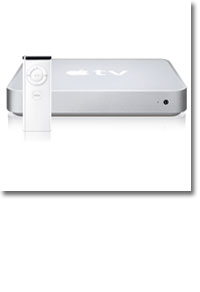
Review: Apple TV
- Article 8 of 16
- Macworld, May 2007
Apple’s easy to use media-streaming device, the Apple TV, arrives in the UK
Page 1 | Page 2 | All 2 Pages
The marketing is persuasive. You can have up to six Macs or PCs connected to an authorised Apple TV on your wireless network (or wired network, thanks to a 10/100 base-T Ethernet port). Then it can play all the content stored on its hard drive or streamed for your computer over the network while you, your friends and loved ones sit on a sofa, watching the television, instead of staring at a computer monitor.
High-def owners club
While this is all well and good, it doesn’t work in practice as perfectly as we’d like. First, the Apple TV has a very modern set of TV connection options: HDMI and component video. If you’ve already invested in a high-definition TV with DVI, component or HDMI sockets, connecting the Apple TV to it is simply a matter of getting the right cable.
If you haven’t yet bought a HD television, you’re far more likely to have a SCART or phono connection. You might be lucky and have a SCART socket that can accept component video via a simple adapter cable. More likely, you have regular old RGB SCARTs, in which case there is one hope for you: J.S. Technology’s Component (YUV) to RGB/VGA converter. We soon managed to have our Apple TV up and producing a brilliant picture on our RGB SCART-equipped TV using this converter, which currently costs £90. Still, it’s a needless expense and we really say the Apple TV is only for people with HD television sets.
Apple explained to us that it didn’t want to use “legacy” television sets and that the high definition standard enables it to create a crisper and more visually appealing interface. There may be some truth in this, but we’re not convinced that the trade off is worth excluding the entire market of non-HDTV owners.
Once you get it up and running, the Apple TV is actually a pleasing gadget to use. It’s beautiful to look at and the interface is very much like Front Row’s menu system, only far more responsive – except when the Apple TV is synchronising, when everything slows down – and it uses the same Apple Remote Control as supplied with all new Macs.
Music playback is good, taking full advantage of your album covers for on-screen display, although lacking the iTunes visualisers some might prefer. Photo playback isn’t so good though, only giving you the option to view an album as a slideshow: you can alter how often slides flip, what music and transitions to use and whether to use the Ken Burns Effect or not, but anything more sophisticated is out of the question. Like the music interface, photo playback also fails to take advantages of groupings by folder that you might have set up in iTunes or iPhoto, so if you have an extensive list of iPhoto albums, you’ll find it hard to navigate through them. Still, it’s far nicer and more convenient to watch photographs on your television than gathering round the computer.
As soon as you’ve set up the device you’ll need to get content onto your Apple TV. To do that, you’ll need to connect it to your home network. The simplest method is Ethernet, since all you have to do is plug a cable into the back of the Apple TV. Given the size of the files potentially being pushed around, it’s somewhat disappointing that gigabit Ethernet isn’t an option, but 100BaseT is more than sufficient.
Television network
For true wireless freedom though, Apple has included support for standard 802.11b/g networks as well as for the new 802.11n standard. Joining the Apple TV to a wireless network is surprisingly easy. You simply select it from a menu of discoverable networks. If a password is needed, you use an on-screen keyboard to enter the password character by character, which is far simpler than it sounds.
Once you’ve joined the network, you choose a computer to sync content with. You can sync with only one computer, but you can stream content from up to five others. Disappointingly, you cannot stream photos. As when syncing an iPod, you can specify which tracks, shows, playlists and types of videos to put on your Apple TV. Given you’ve only 33GB to play with (since 7GB of the nominal 40GB the Apple TV’s hard drive has to offer is taken up with software and formatting) that’s something you’ll probably end up doing out of necessity. Streaming the music rather than syncing it helps, as does the reasonably smart syncing (sync only unwatched or recent shows, for example).
Sync when you’re winning
A nice touch is that syncing happens whenever you do something in iTunes. That means that you’ll find your iPod stays up-to-date with your Apple TV-viewing and vice versa, a blessing for the telly addict, but somewhat a curse for one who shares an Apple TV and finds their partner has been watching shows without them.
Page 1 | Page 2 | All 2 Pages


